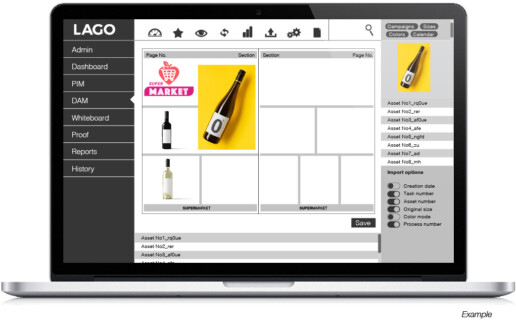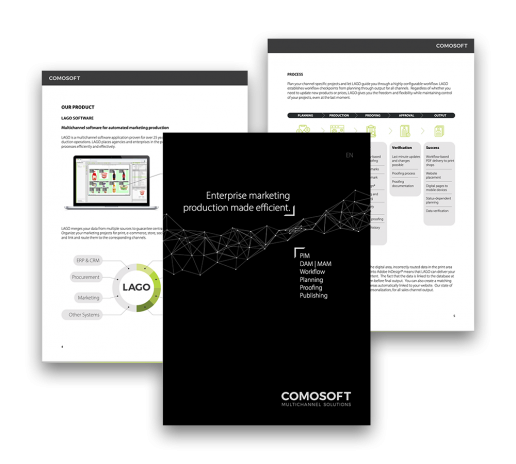Efficient digital asset management reduces costs and time
With LAGO Digital Asset Management (DAM), you can solve one of the most time-consuming challenges in multichannel marketing: the organization and management of your media assets. The goal is clear: media data should be found quickly, kept up-to-date, and remain controllable. The Digital Asset Management System in LAGO is tailored to the processes in product marketing. All assets such as images, logos, videos, graphics, icons, etc. are stored centrally and media-neutrally in the system and the various output formats are created automatically. Integrated into the PIM system and publishing tools, LAGO DAM offers you fast access to media data at any time as well as maximum data integrity.

Five success factors of a DAM system:
- Control the management of digital assets out of a single repository and reduce costs and time
- Forward assets to team members via a central platform that can be opened in any web browser
- Efficiently automate cataloging of assets for different channels or productions, and use automatic asset-to-product mapping
- Ensure proper usage of brand materials and guidelines
- Preserve critical data from loss or isolation on employee´s device
Who benefits particularly from a DAM system?
Creative teams: Designers, photographers, video producers and art directors can manage their digital assets in a single system. This alone enables your company to have a more efficient workflow between your creative teams, marketing teams, category management and sales teams. Your design staff can now focus on what they do best: being creative.
Marketing: Many marketers spend hours searching for the most up-to-date image for print and digital campaigns. With a central repository for digital assets, marketers and sales representatives can efficiently search for the content they need for campaigns and marketing materials or online activities in social media. They can easily share these assets with external staff, distributors and agencies to increase their team’s capacity and ensure that marketing materials are distributed properly.
Are you interested in our white paper about the LAGO DAM system?
We are pleased to be able to offer you valuable insights into this key component of our multichannel software. Please fill out the contact form below to receive the whitepaper by e-mail. Your enquiry is important to us and we will get back to you as soon as possible.
- Asset types, asset metadata and keywords
- Assign assets to other objects
- Full integration into LAGO applications
- Define access, visibility and usability restrictions
- Powerful search engine
- Easy access for external users
- Access LAGO DAM by using the LAGO API
Contact us for a live demo!
Interested in how to reduce the effort and time spent on marketing production? See how we can help!
How the LAGO digital asset management solution can help you succeed
Comosoft’s LAGO DAM system is a powerful and media-neutral repository for your digital assets, product images and videos. Using a comprehensive, standards-compliant approach to metadata, LAGO easily imports and maintains product-specific assets in a secure, centralised location, enabling users to collaborate and be more productive.
Users access their digital assets via their web browser – eliminating the need for verbal requests and an asset silo. Collaborative workflow tools are already integrated into our LAGO multichannel production system to create print and digital marketing communications across teams. As assets are updated or replaced, our digital asset management solution automatically replaces the image in any active media campaign. Brand-building assets can be tracked in LAGO to ensure effective marketing and creative branding.
The LAGO DAM system can be integrated into other relevant systems. These systems include our LAGO PIM system or existing third-party PIM systems. We work individually with your team to help them create and benefit from new, efficient and clearly defined workflows. Our goal is not just an integrative IT solution; for more than 25 years we have been working to optimise the handling of product information and workflow efficiency in every business situation, regardless of which system you have implemented.
LAGO Digital Asset Management Advantages
Centralized Storage
Centralize the storage of your digital assets ensuring your teams can access and utilize your brand’s files correctly and consistently.
Internal Workflow Optimization
Eliminate schedule shifts and delays in projects due to material requests and time-consuming searches for the latest assets.
External Collaboration
Ensure a consistent brand experience by sharing your strategically selected assets with external service providers through your digital asset management tool.
Efficient administration
The traditional method of storing and organising your assets can be chaotic and inefficient. DAM remedies this by providing a centralised platform for storing and managing this content. This centralised database not only enables secure storage, but also prevents the proliferation of duplicates. This means less time wasted searching for assets and therefore a considerable saving in resources.
Legal requirements
In the digital world, copyright and data protection are of crucial importance. DAM systems help companies to ensure compliance with legal regulations. They enable the tracking of usage rights and provide control over access to sensitive information. This minimises the risk of legal issues and protects your company's intellectual property.
Increase brand consistency
Your brand is a valuable asset and the consistency of your message is critical. DAM systems enable the centralised management of brand materials, from logos to marketing materials. This ensures that your brand appears uniform and professional without risking inconsistencies. This is especially important if different departments or teams use your brand materials.
LAGO DAM Features
- Organize digital assets and filter them by metadata
- Access to digital assets from every LAGO application and InDesign Plugin
- Use LAGO web client to create download packages for external collaboration
- Quick, multi-factor digital asset search engine
- Full text search within metadata
- Access to LAGO DAM using LAGO-API
- Automatic Asset-Product-Assignment
- User-defined metadata for categorizing asset types
- Assign keywords to filter digital assets efficiently
- Protection against loss or manipulation of assets through user permissions
- Limiting the use of assets through time limits
- LAGO Workflow for efficient workflow management in image approval
- Automatic quality check during the import of images
- Asset-Check-in/out-Process for Adobe Photoshop, Illustrator, InDesign etc.
- Automatic asset derivative upon export to downstream systems
- Automatic creation of low-resolution preview files for layout creation
- Supports XMP/EXIF meta data
- Supports all relevant image formats
- Supports Microsoft Office documents
Frequently Asked Questions about Digital Asset Management
Digital asset management is the storage, administration and centralization of digital contents. These functions are used in a DAM system.
A digital asset is, generally speaking, any digital information in the form of files. These assets include above all media files such as:
- Photos
- Graphics
- Videos
- Audio files
- Text and HTML files
- Presentations
The abbreviation MAM stands for media asset management, with what DAM stands for digital asset management. A MAM is in most cases mainly aligned to the storage of picture, video and audio files. A DAM takes this idea further by also storing, centralizing and managing other types of files that are important for a consistent brand experience (text and HTML files, presentations, etc.).
The importance of DAM systems for companies is constantly increasing with the growing variety of products and the growing need for virtual networking of teams at international locations.
In a DAM system, for example, it is possible to filter on the basis of metadata that is read from the stored assets. In addition, this administrative system offers the possibility to store own metadata for the assets, which allows a meaningful administration and filtering in company processes. This function in a DAM accelerates, for example, the design process for data-intensive advertising material productions. A DAM system can be used in conjunction with or in addition to a PIM system to support the optimization of processes and workflows within departments and, above all, with location-based team responsibilities. A digital asset management system also plays a major administrative, centralizing and provisioning role in the uniformity of a company’s brand image.
Our consultants help you to find the right solution
Whether you need automated processes or a multichannel output of your advertising material production, our experts are at your disposal for all your questions. Despite standard software, we give our customers the necessary flexibility to adapt LAGO optimally and individually to their processes and organization.

Contact us for a live demo!
Interested in how to reduce the effort and time spent on marketing production? See how we can help!
Find out more about digital asset management in our blog
Stay up to date with us and read more about digital asset management. Find out how a DAM system can simplify your internal processes and help your marketing team work more efficiently.
Reduce time to market in the manufacturing industry with DAM
17. July 2024
Is a slow product development lifecycle getting in the way of your ability to corner the market? Time to Market (TTM) is a pivotal success factor in the manufacturing industry, particularly when developing new products.
The Top 10 DAM Best Practices: Organizing The Chaos
1. July 2024
10 best DAM practises: Implementing a DAM system can help organize your business processes.
How to prevent 4 common errors in your product information
10. June 2024
Product information data should help you understand and locate all the products in your "catalog". Ideally, this means that everyone in your team and all your third-party partners can access the same information at the same time.



